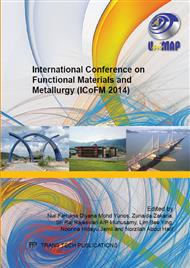p.411
p.417
p.423
p.429
p.437
p.443
p.449
p.455
p.461
Strength of Adhesive T-Joint under Moisture Condition
Abstract:
In this study, an experimental investigation was conducted in order to determine the effect of moisture absorption at different adhesive thickness (i.e., 0.5, 1.0, 1.5 and 2.0 mm) on strength of adhesive T-joint in urea granulator fluidization bed. In particular, T-joint specimens were exposed to three humidity conditions, namely, 80°C, 90°C, and 100°C at a constant time immersion of 15 minutes in water. Stainless steel plate and stainless steel perforated plate were joined by using a specific adhesive jig according to desired thickness. Tensile test was conducted by using universal tensile machine (UTM) at room temperature. The result obtained has enabled to explain the failure mechanisms and characteristics of adhesive T-joint with respect to moisture condition and bonding thickness. Epoxy adhesive with several weight percent of water absorption will degrade the physical properties of the adhesive. Moisture condition has some effect on the strength of the adhesive bonding. 1.0 mm of adhesive thickness provides the highest value of failure load. Experimental results indicated that failure load of adhesive T-joint at room and 90°C water temperature give higher value of strength if compared to water temperature at 80°C and 100°C.
Info:
Periodical:
Pages:
437-442
Citation:
Online since:
June 2015
Authors:
Keywords:
Price:
Сopyright:
© 2015 Trans Tech Publications Ltd. All Rights Reserved
Share:
Citation:


